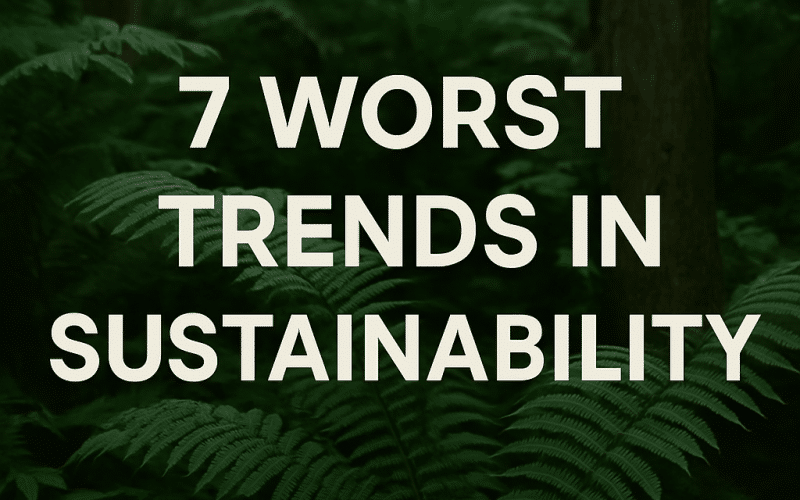
Sustainability, a powerful driver of innovation and reform, risks to become riddled with toxic trends that erode its original purpose. While climate change, biodiversity loss, and social injustice demand urgent action, certain practices delay real progress.
We had a look at 7 of the most damaging trends threatening authentic sustainability – and what needs to change.
- 1 Why it is Important to Identify the Worst Trends in Sustainability
- 2 7 Worst Trends in Sustainability
- 2.0.1 1. Short-termism: Profits Over Planet
- 2.0.2 2. Greenwashing: Deception Disguised as Action
- 2.0.3 3. Over-reliance on Technology: Innovation Without Insight
- 2.0.4 4. Consumerism and Overconsumption: Buying Our Way Into Collapse
- 2.0.5 5. Inequitable Practices: Sustainability for the Privileged Few
- 2.0.6 6. Lack of Regulation and Accountability: Green Claims Without Guardrails
- 2.0.7 7. Misinformation and Lack of Awareness: Confusion in the Climate Crisis
- 3 Clean Up the Sustainability Conversation
Why it is Important to Identify the Worst Trends in Sustainability
Bad sustainability trends aren’t just annoying — they’re dangerous. Misinformation and greenwashing continue to spread, damaging real progress and misleading both consumers and investors. When a company’s public claims don’t match its actual actions, credibility crumbles fast.
Consumers and regulators now dig deeper. They expect clear, honest reporting. That means no more vague promises. Accurate carbon accounting and third-party validation have become essentials, not extras. Skip them, and you risk breaking advertising rules, facing negative press, or triggering investigations and fines.
The real issue? Too many businesses still treat sustainability as a marketing buzzword. They throw around big claims without backing them up. But today’s consumers are paying attention. Over 60% are willing to pay more for products with sustainable packaging. Investors are even more direct: 88% now factor in ESG risks when making decisions.
To stay ahead, you need more than a feel-good message. Create a clear sustainability policy that outlines your mission, the impact of your operations, and real steps to reduce harm. Include measurable goals. Show leadership commitment. Be honest about where you are and where you’re going.
Transparency isn’t optional anymore. It’s what builds trust — and it’s what keeps your brand relevant in a world that’s watching more closely than ever.
7 Worst Trends in Sustainability
1. Short-termism: Profits Over Planet
Short-termism often dominates corporate decision-making. Companies chase quarterly profits at the expense of long-term resilience, environmental health, and social equity. This trend, dubbed “quarterly capitalism,” leads to ecosystem destruction, intergenerational injustice, and missed opportunities for innovation.
What causes it? Behavioral biases like immediate gratification skew decision-making. Organizations often ignore long-term gains due to uncertainty and delayed outcomes.
How to fix it Embed sustainability into strategic planning. Decision-making tools based on behavioral science can shift focus to long-term risk mitigation and resilience. Companies that set clear ESG goals outperform peers – both in reputation and financial performance.
2. Greenwashing: Deception Disguised as Action
Greenwashing is rampant, and we reported already often on it. Companies exaggerate or fabricate environmental claims to appear sustainable. In reality, their operations often remain unchanged.
Why it matters: Greenwashing misleads consumers, pollutes trust, and diverts funds from actual sustainable solutions. It also enables continued environmental degradation behind a smokescreen of false claims.
Examples:
- Fashion brands claiming to be eco-friendly while producing in sweatshops with massive water waste. Fast fashion also results in poor quality products which in the end also undermine the circular second hand economy.
- Oil companies promoting carbon offsets while investing billions in fossil fuel expansion.
Countermeasures: New laws like the EU Green Claims Directive and Canada’s Bill C-59 demand evidence for sustainability claims. Tools like BanQu provide traceability for supply chains and help combat greenwashing.
3. Over-reliance on Technology: Innovation Without Insight
Technology is often framed as a silver bullet for sustainability. While innovations help, blind dependence creates new problems.
The pitfalls:
- Electric vehicles (EVs) reduce emissions but require rare earth mining, which harms ecosystems and communities, despite remaining a better option to fossil fuel vehicles.
- Automated farming may boost yields but displaces labor and overburdens soil.
- High-tech solutions often neglect the social context and systemic causes of unsustainability.
What’s needed: Balance innovation with ethics and local realities. Combine tech with community engagement, policy reform, and circular economy practices.
4. Consumerism and Overconsumption: Buying Our Way Into Collapse
Rampant consumerism, dropshipping being the main factor nowadays, is an environmental time bomb. The more we consume, the more we destroy.
Impact:
- Overproduction drains finite resources.
- Waste generation skyrockets.
- Ecosystems collapse due to deforestation and pollution.
Who fuels it? Both consumers and corporations. Brands push fast fashion, disposable electronics, and constant upgrades. Consumers respond with overbuying.
How to curb it: Companies must design products for durability and recyclability. Governments can tax waste and incentivize reuse. A shared push for degrowth – not just green growth – is crucial.
5. Inequitable Practices: Sustainability for the Privileged Few
Not all sustainability is inclusive. Too often, the benefits accrue to wealthy communities, while costs hit marginalized groups.
Examples:
- Polluting factories near low-income neighborhoods.
- Renewable energy projects that displace Indigenous communities.
Why it matters: Ignoring equity worsens poverty, fuels unrest, and violates Sustainable Development Goals like SDG 1, 3, and 16.
Solution: Value Sharing Ensure sustainable development distributes benefits across society. Equitable sustainability boosts resilience and drives social progress.
6. Lack of Regulation and Accountability: Green Claims Without Guardrails
Loose regulation allows companies to continue unsustainable practices with impunity.
Consequences:
- Greenwashing flourishes.
- Consumers can’t make informed choices.
What’s changing: New rules enforce evidence-based claims, but enforcement remains inconsistent. Regulatory clarity helps companies avoid “greenhushing”.
What’s needed:
- Clear sustainability frameworks.
- Mandatory reporting standards.
- Third-party audits.
7. Misinformation and Lack of Awareness: Confusion in the Climate Crisis
Misinformation clouds public understanding of sustainability. It spreads through vague corporate claims, clickbait headlines, and inconsistent definitions. But it also is rampant within the climate ‘community’ with degrowth being presented as the best solution, and nuclear energy for example as a devilish technology.
The damage:
- Consumers support polluters unknowingly.
- Real progress is overshadowed by noise.
- Investors can’t differentiate between genuine ESG performance and greenwashing.
- Unrealistic economic strategies are being presented as the only way out.
Combatting the noise:
- Fact-based sustainability education.
- Transparent carbon accounting.
- Verified reporting from trusted platforms.
Over 60% of consumers are willing to pay more for genuinely sustainable products. Investors also respond – 88% now factor ESG into decisions.
Organizational response: Every company needs a sustainability policy with:
- Mission statement
- ESG integration
- Short- and long-term targets
- Board-level accountability.
Clean Up the Sustainability Conversation
The worst trends in sustainability aren’t just frustrating – they’re dangerous. They delay action, mislead the public, and deepen ecological and social crises. To reverse them, we need:
- Long-term planning over short-term profit.
- Honest claims, not greenwashing.
- Balanced tech use, not blind faith.
- Conscious consumption.
- Equity in every initiative.
- Clear regulation.
- Misinformation detox.
Only then can sustainability mean what it was always meant to: a just, livable future for all.
